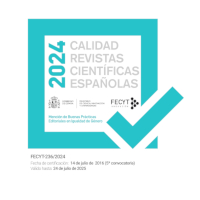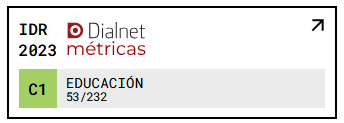El ordenador en trabajos prácticos : Análisis de una experiencia en el aula de Física de Educación Secundaria
DOI:
https://doi.org/10.18172/con.370Abstract
In this paper is analyzed the effect on the learning of the propasal of a practical work on Physics tor the Secondary Education pupils, related to fall of the weights. In the experimental design of practical work takes part the computer as a means of experimental data acquisitíon of speed and weights time that slide in a surface without rubbing and in free fall. The analysis of the results obtained with two experimental groups, as compared to other two control groups in a Secondary Education Center, índicates that the accomplishment of laboratory experiences, designed in the practical projects where takes part the computer, is capable of contributing to the significant learning in Elemental Dynamics more than by other traditional means. The significant learning is shown when the mental schemes of the pupils become coherent with the scientific ideas, and this is revealed by a significant decrease of the alternative ideas (misconceptions, spontaneous ideas or preconceptions), with respect to those which they had befare of the leaming process.Downloads
References
ACEVEDO, J. A., BOLÍVAR, J. P., LÓPEZ-MOLINA, E. J. y TRUJILLO, M. (1989). Sobre las concepciones en dinámica elemental de los adolescentes formales y concretos y el cambio metodológico. Enseñanza de las Ciencias. 7(1), 27-34.
AYENSA, J. M., CABIA, A. y SAIZ, M. C. (1996). Esquemas conceptuales de los alumnos de Enseñanza Media. Calahorra. La Rioja. CEPR.
DRIVER, R., GUESNE, E. y TIBERGHIEN, A. (1989). Ideas Científicas en la infancia y la adolescencia. Madrid. Morata/MEC.
CARRASCOSA, J. y GIL, D. (1992). Concepciones alternativas en mecánica. Enseñanza de las Ciencias, 1 O (3), 314-328.
CLEMENT, J. (1982). Students preconceptions in introductory mechanics. American Journal of Physics. 50(1), 66-71.
GUTIÉRREZ GONCET, R. (1994). Coherencia del pensamiento espontáneo y causalidad. El caso de la Dinámica elemental. Tesis doctoral no publicada. Madrid. Universidad Complutense.
HEWSON, P. W. (1990). La enseñanza de «fuerza y movimiento» como cambio conceptual. Enseñanza de las Ciencias. 8(2), 157-172.
HERRÁN, C. y PARRILLA, J. L. (1994). La utilización del ordenador en la realización de experiencias de laboratorio. Enseñanza de las Ciencias, 12(3), 393-399.
HIERREZUELO, J. y MONTERO, A. (1989). La Ciencias de los alumnos (su utilización en la didáctica de la Física y Química). Madrid. LAIA/MEC.
HIERREZUELO et al. (1993). Ciencias de la Naturaleza. Física y Química. Educación Secundaria 4º curso. Vélez-Málaga. Elzevir.
McDERMOTT, L. C. (1984). Research on conceptual undestanding in mechanics. Physics Today, july 1984.
OSBORNE, R. J. y FREEMAN, J. (1989). Teaching Physics. A guide for non specialist. Cambridge University Press.
PALACIOS, C., DEL MORAL PÉREZ, Mª E. y VARELA Mª P. Conocimientos científicos en la escuela. (Resultados de la investigación IAP92). Madrid. CIDE. MEC.
POZO, J. I. (1987). Aprendizaje de la Ciencia y pensamiento causal. Visor Libros. Madrid.
ROSADO y colaboradores (1992, 1993, 1994, 1995 y 1996). Didáctica de la Física y sus nuevas tendencias. Madrid. UNED.
SEBASTIÁ, J. M. (1984). Fuerza y movimiento: la interpretación de los estudiantes. Enseñanza de las Ciencias, 2(3), 161-169.
TROWBRIDGE, D. E. y McDERMOTT, L. C. (1981). lnvestigation of students understanding of the concept to acceleration in one dimension. American Journal of Physics. St Louis, 49(3) 242-257.
VIENNOT, L. (1979). Le raisonnement spontané en dynamique élementaire. Paris. Hermann.
VIENNOT, L. (7 996). Raisonner en Physique. La part du sens commun. París. De Boeck Université. (Coll. Practiques Pedagogiques).
Downloads
Published
How to Cite
Issue
Section
License
The authors retain copyright of articles and authorize Contextos Educativos. Revista de Educación the first publication. They are free to share and redistribute the article without obtaining permission from the publisher as long as they give appropriate credit to the editor and the journal.
Self-archiving is allowed too. In fact, it is recommendable to deposit a PDF version of the paper in academic and/or institutional repositories.












